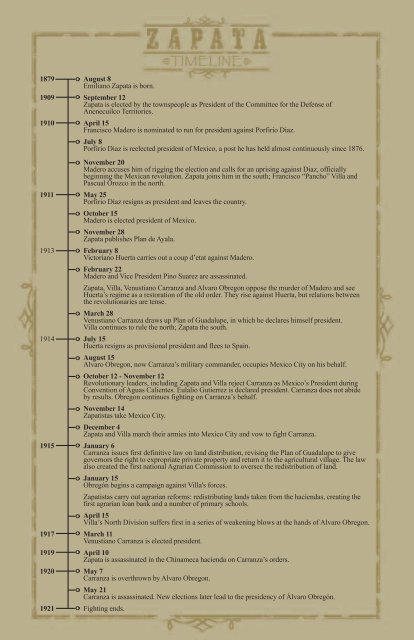Zapata Project 1
Zapata Project 1
Zapata Project 1
You also want an ePaper? Increase the reach of your titles
YUMPU automatically turns print PDFs into web optimized ePapers that Google loves.
1879 August 8<br />
Emiliano <strong>Zapata</strong> is born.<br />
1909 September 12<br />
<strong>Zapata</strong> is elected by the townspeople as President of the Committee for the Defense of<br />
Anenecuilco Territories.<br />
1910 April 15<br />
Francisco Madero is nominated to run for president against Porfirio Diaz.<br />
July 8<br />
Porfirio Diaz is reelected president of Mexico, a post he has held almost continuously since 1876.<br />
November 20<br />
Madero accuses him of rigging the election and calls for an uprising against Diaz, officially<br />
beginning the Mexican revolution. <strong>Zapata</strong> joins him in the south; Francisco “Pancho” Villa and<br />
Pascual Orozco in the north.<br />
1911 May 25<br />
Porfirio Diaz resigns as president and leaves the country.<br />
October 15<br />
Madero is elected president of Mexico.<br />
November 28<br />
<strong>Zapata</strong> publishes Plan de Ayala.<br />
1913 February 8<br />
Victoriano Huerta carries out a coup d’etat against Madero.<br />
February 22<br />
Madero and Vice President Pino Suarez are assassinated.<br />
<strong>Zapata</strong>, Villa, Venustiano Carranza and Alvaro Obregon oppose the murder of Madero and see<br />
Huerta’s regime as a restoration of the old order. They rise against Huerta, but relations between<br />
the revolutionaries are tense.<br />
March 28<br />
Venustiano Carranza draws up Plan of Guadalupe, in which he declares himself president.<br />
Villa continues to rule the north; <strong>Zapata</strong> the south.<br />
1914 July 15<br />
Huerta resigns as provisional president and flees to Spain.<br />
August 15<br />
Alvaro Obregon, now Carranza’s military commander, occupies Mexico City on his behalf.<br />
October 12 - November 12<br />
Revolutionary leaders, including <strong>Zapata</strong> and Villa reject Carranza as Mexico’s President during<br />
Convention of Aguas Calientes. Eulalio Gutierrez is declared president. Carranza does not abide<br />
by results. Obregon continues fighting on Carranza’s behalf.<br />
November 14<br />
Zapatistas take Mexico City.<br />
December 4<br />
<strong>Zapata</strong> and Villa march their armies into Mexico City and vow to fight Carranza.<br />
1915 January 6<br />
Carranza issues first definitive law on land distribution, revising the Plan of Guadalupe to give<br />
governors the right to expropriate private property and return it to the agricultural village. The law<br />
also created the first national Agrarian Commission to oversee the redistribution of land.<br />
January 15<br />
Obregón begins a campaign against Villa's forces.<br />
Zapatistas carry out agrarian reforms: redistributing lands taken from the haciendas, creating the<br />
first agrarian loan bank and a number of primary schools.<br />
April 15<br />
Villa’s North Division suffers first in a series of weakening blows at the hands of Alvaro Obregon.<br />
1917 March 11<br />
Venustiano Carranza is elected president.<br />
1919 April 10<br />
<strong>Zapata</strong> is assassinated in the Chinameca hacienda on Carranza’s orders.<br />
1920 May 7<br />
Carranza is overthrown by Alvaro Obregon.<br />
May 21<br />
Carranza is assassinated. New elections later lead to the presidency of Álvaro Obregón.<br />
1921 Fighting ends.







